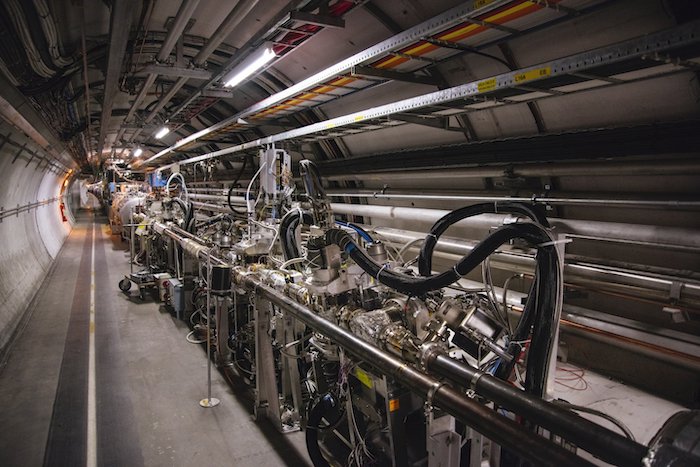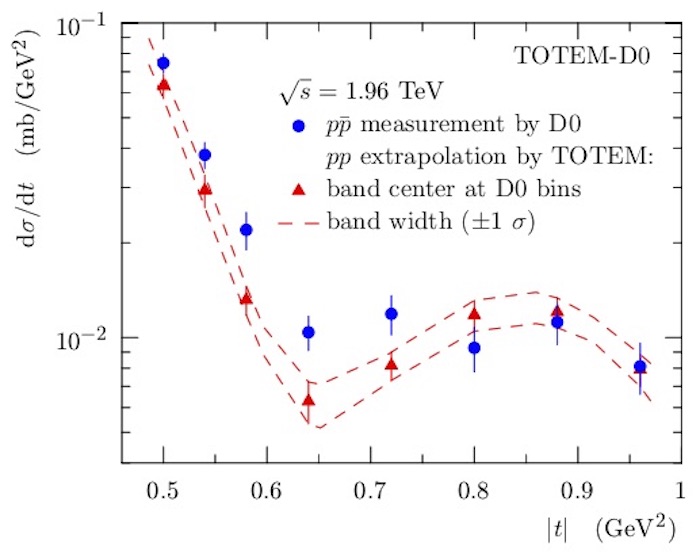KU researchers announce odderon observation, hunted for 50 years by particle physicists

LAWRENCE — High-energy experimental particle physicists from the University of Kansas stand at the forefront of a major discovery by the D0 and TOTEM collaborations from tests at the Large Hadron Collider (the world’s largest particle accelerator, situated in a 17-mile circular tunnel beneath the border of France and Switzerland) and the Tevatron at Fermilab in Illinois.
The findings shed light on the fundamental makeup of all matter in the universe.

In a new paper submitted to Physical Review Letters by the D0 and TOTEM collaborations, corresponding author Christophe Royon, Foundation Distinguished Professor of Physics and Astronomy at KU, describes experimental evidence for the existence of a three-gluon compound dubbed the “odderon.” The observations come from experiments where protons are smashed together at near-light-speed as scientists carefully parse the results. (PDF of "Comparison of pp and pp¯ differential elastic cross sections and observation of the exchange of a colorless C-odd gluonic compound")
The odderon was hypothesized in 1973 under the Regge theory of strong interactions. In “quantum chromodynamics,” the theory of quark and gluon interaction, this is represented by a compound of three gluons. But, until now, the odderon’s existence has remained conjectural and considered by some as a mere academic discussion. The new findings carry a high standard of evidence or observation (5 sigma, where “sigma” among particle physicists is used as a measure of the statistical probability of the evidence).
“This means that if the odderon did not exist, the probability that we observe an effect like this in the data by chance would be 1 in 3.5 million,” said Cristian Baldenegro, a KU graduate student in Royon’s group.

“There were many attempts to look for the odderon at all accelerators since the 1950s, but none of them could get 5 sigma,” Royon said. “There was an effect between proton-proton and proton-antiproton collisions seen already at CERN in the ISR (the Intersecting Storage Rings, an earlier particle accelerator active in the '70s), but it was less than 3 sigma. It was not more than a possible indication and might have been due to other reasons at lower energies, for instance, meson exchanges.”
The new findings concern hadrons — the family of particle that includes protons and neutrons. Hadrons are formed by quarks “glued” together with gluons. Previously, scientists have observed collisions involving only an even number of gluons exchanged between the protons. In these collisions, protons remain intact after the collision, a process known as elastic scattering.
Now, Royon and his colleagues show 5 sigma observation of an odd number of gluons, without any quarks, exchanged in the collisions. The measurements confirm earlier evidence by Royon and his collaborators from the TOTEM experiment.
Royon, who leads the analysis group from both TOTEM and D0 collaborations, said conclusively establishing the odderon’s existence after years of research required many technological developments that down the road could lead to breakthroughs in everyday life. For instance, the detectors used to discover the odderon could have medical uses.
“There are technological developments that are used in the proton detectors nowadays,” he said. “Silicon pixel detectors to measure the proton positions, and ultrafast silicon detectors that are also developed at KU, that are used every day in these proton detectors. They have many applications such as the measurement of radiation during cancer treatments. We submitted a publication in collaboration with a hospital in Dublin, Ireland, that shows how these detectors can revolutionize the measurement of radiation in medicine, as well as the measurements of radiation that we perform in collaboration with NASA in the AGILE project.” (PDF of "A novel technique for real-time ion identification and energy measurement for in situ space instrumentation")
Royon has been involved with the D0 Collaboration at Fermilab since 1999 and in the TOTEM collaboration since 2014. Other KU personnel involved in the D0 project include Alice Bean, University Distinguished Professor of Physics & Astronomy; Graham Wilson, professor of physics & astronomy, and Phil Baringer, professor of physics & astronomy. KU researchers at the TOTEM experiment at the LHC include postdoctoral researcher Nicola Minafra and doctoral students Baldenegro, Justin Williams, Cole Lindsey and Tommaso Isidori.
"Searching for signatures of the odderon is a very different task in comparison to what is traditionally done in particle physics," Baldenegro said. "For instance, in searching for the Higgs boson or the top quark, one looks for a 'bump' over a smooth invariant mass distribution, which is already very challenging. The odderon, on the other hand, has much more subtle signatures. This has made the hunt for the odderon so much more challenging.''